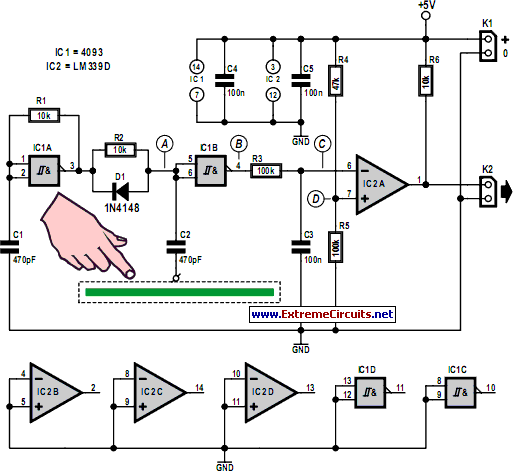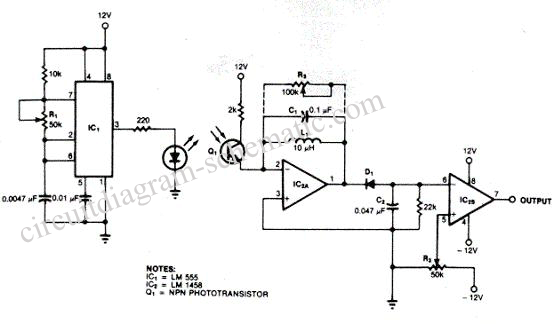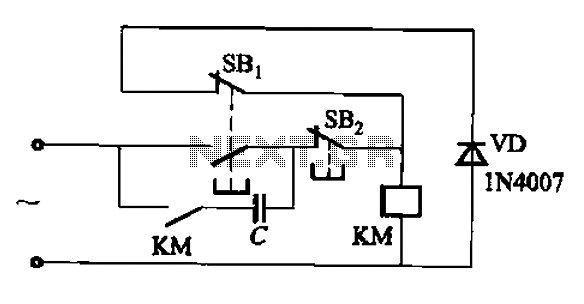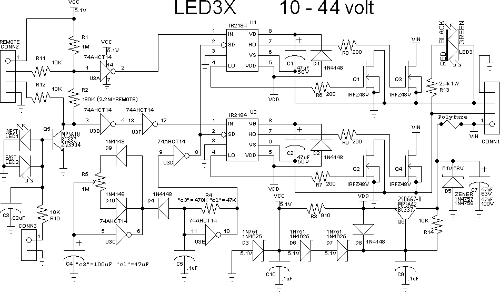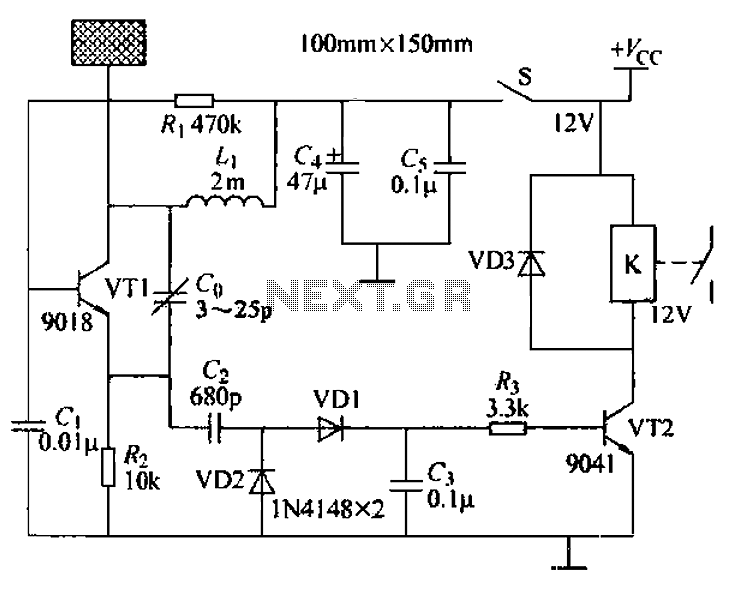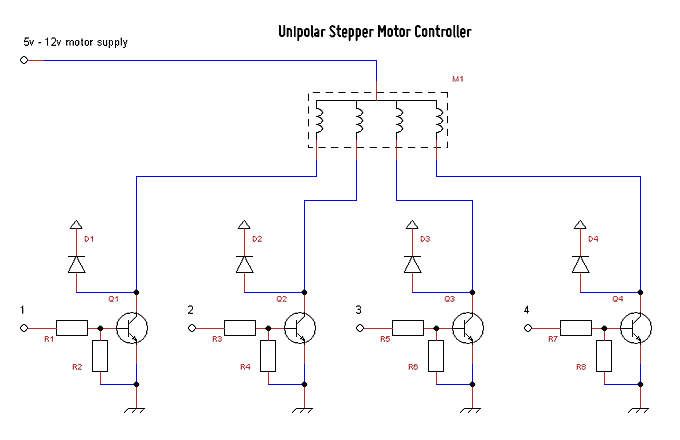
Capacitive Sensors
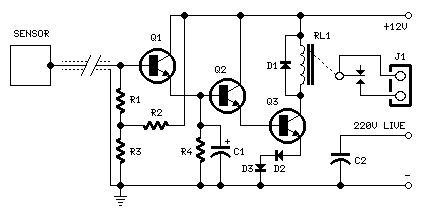
For proper operation, the circuit ground must be connected through a small-value, high-voltage-rated capacitor to one side of the mains supply socket. The "Live" side is the right one. This circuit is designed to animate shop windows using a capacitive sensor placed behind a postcard-like banner. The card is positioned against the glass in front of the shop window, allowing visitors to activate the relay by placing their hand on the card from outside. This setup is particularly suitable for toy shops, as it can activate model trains, small electric racing cars, lights, and more. Further applications are left to the user's imagination. This circuit can enhance the impact of shop windows during the Christmas season. Transistors Q1, Q2, and Q3 form a high-impedance super-Darlington configuration that drives the relay, amplifying the 50Hz alternating mains supply frequency induced in the sensor by the human body. Capacitor C1 and diodes D2 and D3 ensure clean relay switching. The power supply can be any commercial wall plug-in transformer with a rectifier and smoothing capacitor, capable of providing the necessary voltage and current to power the intended relay.
The circuit utilizes a capacitive sensing mechanism that detects the presence of a human hand near the postcard-like banner. When a visitor approaches and places their hand on the card, the capacitive sensor detects the change in capacitance caused by the proximity of the human body. This triggers the super-Darlington transistor arrangement, which is highly sensitive and capable of amplifying the small signal induced by the sensor.
Transistors Q1, Q2, and Q3 are configured in such a way that they work together to provide a high gain, ensuring that even minimal changes in capacitance can activate the relay. The relay serves as a switch that can control various devices such as lights, motors, or other electronic components, making it versatile for different display applications.
Capacitor C1 plays a critical role in stabilizing the circuit operation, filtering out noise and ensuring that only the intended signal activates the relay. Diodes D2 and D3 are included to protect the circuit from back EMF generated by the relay coil when the relay is deactivated. This protection is essential for maintaining the integrity of the circuit and prolonging the lifespan of the components.
For the power supply, a commercial wall plug-in transformer is recommended, which should provide a rectified and smoothed output voltage suitable for the relay's operational requirements. The transformer should be selected based on the current ratings of the relay to ensure reliable operation.
In summary, this circuit provides an innovative solution for enhancing shop window displays, utilizing capacitive sensing technology to create an interactive experience for customers while being easy to implement with readily available components.For proper operation, circuit ground must be connected via a small value, high voltage-rating capacitor to one side of the mains supply socket. The "Live" side is the right one. The purpose of this circuit is to animate shop-windows by means of a capacitive sensor placed behind a post-card-like banner.
The card is placed against the glass in side the shop-window, and the visitor can activate the relay placing his hand on the card, from the outside. Especially suited for toy-shops, the circuit can activate model trains, small electric racing cars, lights etc.
Further applications are left at user`s imagination. Adopt it to increase the impact of your shop-window on next Christmas season! Q1, Q2 & Q3 form a high impedance super-Darlington that drives the relay, amplifying the 50Hz alternate mains-supply frequency induced in the sensor by the human body. C1 & D2, D3 ensure a clean relay`s switching. Power supply can be any commercial wall plug-in transformer with rectifier and smoothing capacitor, capable of supplying the voltage and current necessary to power the relay you intend to use.
🔗 External reference
The circuit utilizes a capacitive sensing mechanism that detects the presence of a human hand near the postcard-like banner. When a visitor approaches and places their hand on the card, the capacitive sensor detects the change in capacitance caused by the proximity of the human body. This triggers the super-Darlington transistor arrangement, which is highly sensitive and capable of amplifying the small signal induced by the sensor.
Transistors Q1, Q2, and Q3 are configured in such a way that they work together to provide a high gain, ensuring that even minimal changes in capacitance can activate the relay. The relay serves as a switch that can control various devices such as lights, motors, or other electronic components, making it versatile for different display applications.
Capacitor C1 plays a critical role in stabilizing the circuit operation, filtering out noise and ensuring that only the intended signal activates the relay. Diodes D2 and D3 are included to protect the circuit from back EMF generated by the relay coil when the relay is deactivated. This protection is essential for maintaining the integrity of the circuit and prolonging the lifespan of the components.
For the power supply, a commercial wall plug-in transformer is recommended, which should provide a rectified and smoothed output voltage suitable for the relay's operational requirements. The transformer should be selected based on the current ratings of the relay to ensure reliable operation.
In summary, this circuit provides an innovative solution for enhancing shop window displays, utilizing capacitive sensing technology to create an interactive experience for customers while being easy to implement with readily available components.For proper operation, circuit ground must be connected via a small value, high voltage-rating capacitor to one side of the mains supply socket. The "Live" side is the right one. The purpose of this circuit is to animate shop-windows by means of a capacitive sensor placed behind a post-card-like banner.
The card is placed against the glass in side the shop-window, and the visitor can activate the relay placing his hand on the card, from the outside. Especially suited for toy-shops, the circuit can activate model trains, small electric racing cars, lights etc.
Further applications are left at user`s imagination. Adopt it to increase the impact of your shop-window on next Christmas season! Q1, Q2 & Q3 form a high impedance super-Darlington that drives the relay, amplifying the 50Hz alternate mains-supply frequency induced in the sensor by the human body. C1 & D2, D3 ensure a clean relay`s switching. Power supply can be any commercial wall plug-in transformer with rectifier and smoothing capacitor, capable of supplying the voltage and current necessary to power the relay you intend to use.
🔗 External reference
